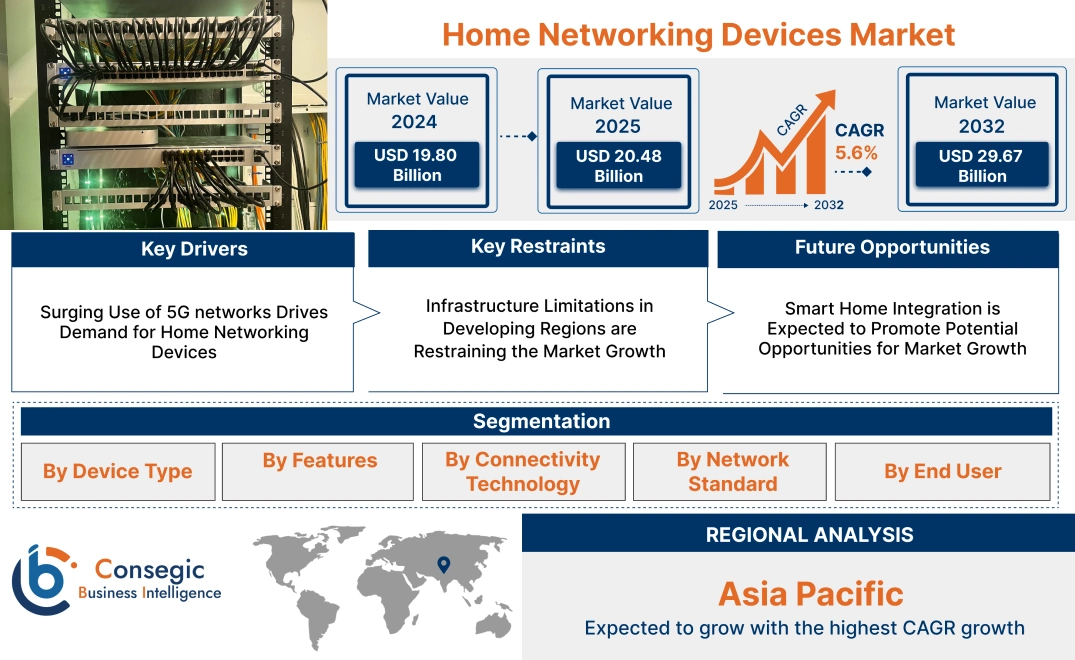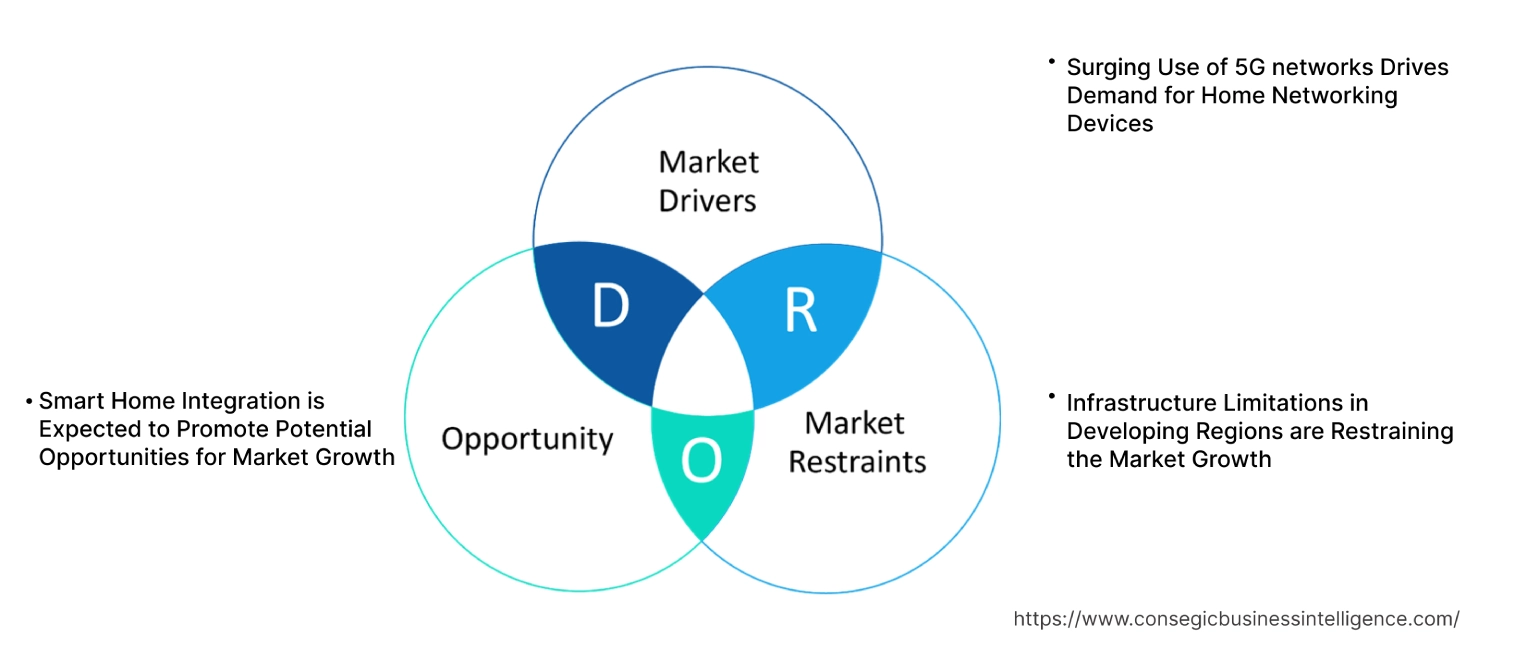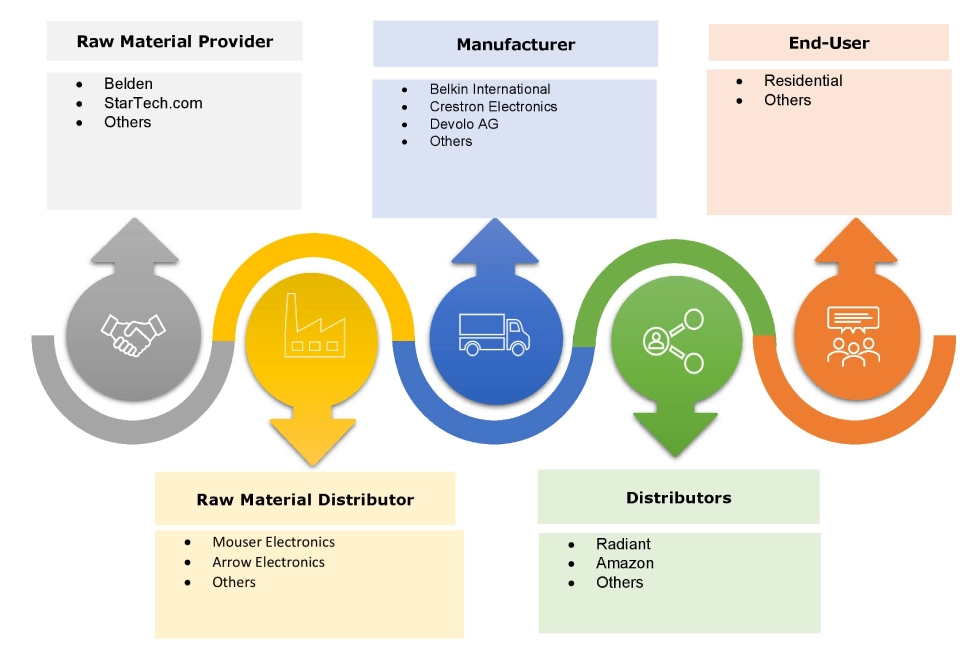- Summary
- Table Of Content
- Methodology
Home Networking Devices Market Size:
Home Networking Devices Market size is estimated to reach over USD 29.67 Billion by 2032 from a value of USD 19.80 Billion in 2024 and is projected to grow by USD 20.48 Billion in 2025, growing at a CAGR of 5.6% from 2025 to 2032.
Home Networking Devices Market Scope & Overview:
Home networking devices are a combination of hardware such as routers, modems, switches, and others to create a network in a home. Also, the devices are connected to the network via Wi-Fi or ethernet cables. Additionally, the advantages including enhanced security, cost efficiency, faster speed, and convenient remote access among others are driving the home networking devices market demand. Moreover, the devices are utilized by residential consumers, small offices/home offices (SOHO), and enterprises. Further, the increasing adoption of smart home technology is driving the home networking devices market growth.
Key Drivers:
Surging Use of 5G networks Drives Demand for Home Networking Devices
The rapid expansion of 5G networks and fiber-optic is driving the demand for high performance routers and modems which in turn is boosting the home networking devices market growth. Additionally, the increasing need for low latency and high bandwidth connections for applications such as gaming and remote work is fueling the home networking devices market demand.
- For instance, according to Ericsson mobility report, Approximately 160 million new 5G subscribers were added which totaled to more than 1.7 billion in the first three months of 2024.
Therefore, the development of 5G networks and fiber-optic is driving the adoption of internet, in turn proliferating the growth of the market.
Key Restraints:
Infrastructure Limitations in Developing Regions are Restraining the Market Growth
The limited access to internet in rural and undeveloped regions is hindering the adoption of advanced networking devices which in turn is restraining the home networking devices market expansion. Additionally, high dependency on traditional wired broadbands is hindering the adoption of wireless networking solutions. Further, unstable power supply in developing regions affects the reliability and adoption of home networking solutions.
Therefore, the limited access to internet and high dependency on traditional wired broadbands are restraining the home networking devices market expansion.
Future Opportunities :
Smart Home Integration is Expected to Promote Potential Opportunities for Market Growth
The rapid digitalization across regions is boosting the adoption of smart home devices which in turn is paving the way for home networking devices market opportunities. Additionally, the rising need for connected devices such as TV, thermostats, and lighting among others is driving the market development. Further, the emergence of Wi-Fi 6 and Wi-Fi 6e are enabling faster and more efficient connectivity solutions for multiple devices is driving the market evolution.
- For instance, in March 2025, TP-Link launched AI powered Wi-Fi solutions for smart homes to offer features such as real-time analytics, health checks, and auto-optimization among others. Additionally, the solution is ideal for lowering operational costs and risks.
Hence, the rapid digitalization is anticipated to increase the utilization, in turn promoting prospect for home networking devices market opportunities during the forecast period.
Home Networking Devices Market Segmental Analysis :
By Device Type:
Based on the device type, the market is segmented into routers, range extenders, network adapters, modems, and smart hubs.
Trends in the Device Type:
- The rise in technologies such as IoT, 5G and cloud computing are driving the adoption of network adapters which in turn propels the home networking devices market trend.
- The trend towards increasing demand for improved network connectivity for seamless network development is driving the need for range extenders.
Routers accounted for the largest revenue share in the year 2024 and is anticipated to register the fastest CAGR during the forecast period.
- Router is a device which connects home network to the internet. Also, the routers are built-in with AI and NPU for reducing latency, energy consumption and improving performance which are essential for gamers.
- Further, the rise in e-learning and increasing need for smart home devices is driving the adoption of routers which in turn is boosting the home networking devices market share.
- For instance, in January 2025, Asus launched ROG Rapture GT-BE19000AI, RT-BE58 Go, ASUS 5G-Go, ZenWiFi Outdoor series. The series of products are AI router enabled with networking solutions feature for gaming, privacy, energy saving and Wi-Fi stability.
- Thus, according to the home networking devices market analysis, rise in e-learning and increasing need for smart home devices is driving the adoption of routers.
By Features:
Based on the features, the market is segmented into smart home integration, security features, parental controls, QOS (Quality of Service), multi-user MIMO.
Trends in the Features:
- The rise in bring-your-own-device (BYOD) is driving the adoption of multi-user MIMO features which in turn is fueling the home networking devices market trend.
- The increasing demand for protection against cyber-attacks is driving the security features segment in the home networking devices industry.
Multi-User MIMO accounted for the largest revenue share in the year 2024.
- Multi-user MIMO is a wireless technology supporting environments where multiple users access the same network simultaneously. Also, the feature leverage multiple antennas to improve communication by creating multiple connections to devices.
- Additionally, the advantages of multi-user MIMO features include increased network efficiency, reduced latency, and faster upload & download speed among others which in turn is boosting the home networking devices market share.
- Further, Wi-Fi 6 and Wi-Fi 6E are advanced wireless standards catering to the growing demand of modern businesses and homes which in turn is driving the adoption of multi-user MIMO features to maximize the abilities of new generation Wi-Fi standards.
- Thus, as per the market analysis, advanced wireless standards as well as aforementioned advantages are driving the adoption of multi-user MIMO features.
Smart Home Integration is anticipated to register the fastest CAGR during the forecast period.
- The devices such as routers, mesh systems, and hubs are utilized to enable smart home integration features.
- Additionally, the increasing adoption of smart thermostats, smart security cameras, and smart lighting system among others are driving the need for smart home integration features.
- Further, the smart home devices are dependent on stable and reliable Wi-Fi connection for communications and easy operation which in turn provides seamless smart home experience.
- For instance, in March 2025, TP-Link launched networking and smart home solutions designed for service providers, enterprises and consumers requiring faster and more secure connectivity. Also, the feature offers advanced home automation and connectivity solutions for smart homes.
- Therefore, according to the home networking devices market analysis, the increasing adoption of smart thermostats, smart security cameras and smart lighting system among others are anticipated to boost the market during the forecast period.
By Connectivity Technology:
Based on the connectivity technology, the market is segmented into Wi-Fi, ethernet, powerline, PLC (power line communication), and MOCA (multimedia over coax alliance).
Trends in the Connectivity Technology:
- The MOCA offers reliable, high-speed alternative to Wi-Fi and powerline by providing low latency and easy installation capabilities is driving the market trend.
- The trend towards rise of industrial ethernet for IoT and automation is driving the adoption of ethernet connectivity technology segment.
Wi-Fi accounted for the largest revenue share in the year 2024 and is anticipated to register the fastest CAGR during the forecast period.
- Wi-Fi provides wireless access to the internet and other network resources for facilitating data exchange and internet access.
- Additionally, the advantages of Wi-Fi connectivity technology include increased mobility, ease of installation, and cost-effectiveness among others which in turn drives the home networking devices market size.
- Further, the increasing need for faster and more reliable wireless connectivity is driving the adoption of Wi-Fi connectivity segment.
- Furthermore, the emerging Wi-Fi connectivity technology such as Wi-Fi 6 and Wi-Fi 6E are designed to offer higher speeds, lower latency, and improved efficiency to support emerging applications and the growing number of connected devices.
- Thus, as per the market analysis, increasing need for faster and more reliable wireless connectivity is driving the Wi-Fi connectivity technology segment.
By Network Standard:
Based on the network standard, the market is segmented into Wi-Fi 5 (802.11ac), Wi-Fi 6 (802.11ax), Wi-Fi 6E, and wired (ethernet cable) standards.
Trends in the Network Standard:
- The rise of IoT devices which require faster, reliable, and secure wireless connectivity is driving the adoption of Wi-Fi 6 (802.11ax) standard.
Wired (Ethernet Cable) Standards accounted for the largest revenue share in the year 2024.
- Rising adoption Cat 6 and Cat 7 wired ethernet cables due to the higher data rate of 1 Gbps to 10 Gbps to support higher data speeds at longer distances.
- Further, the rise of AI and automation for network management is driving the adoption of wired (ethernet cable) standard which in turn fuels the home networking devices market size.
- Thus, as per the market analysis, rise of AI and automation for network management is driving the wired (ethernet cable) standard segment growth.
Wi-Fi 6E is anticipated to register the fastest CAGR during the forecast period.
- Wi-Fi 6E is an extension of the Wi-Fi 6 (802.11ax) wireless standard which is designed to provide faster wireless speeds with lower latency.
- Additionally, the benefits of Wi-Fi 6E network standards include speed and security which is driving the adoption in various industries such as healthcare, retail, education, manufacturing, and warehousing, among others.
- Further, the increasing need for Wi-Fi 6E network standards due to its ability to offer increased bandwidth, reduced congestion, and improved performance, especially in dense environments.
- For instance, in August 2021, TP-Link introduced Wi-Fi 6E mesh systems to offer strong, reliable Wi-Fi throughout whole home. Also, the network standard provides congestion-free networking.
- Therefore, as per the market analysis, the increasing focus towards increasing bandwidth and reducing congestion are anticipated to boost the market during the forecast period.
By End User:
Based on the end user, the market is segmented into residential consumers, small office/home office (SOHO), and enterprise.
Trends in the End User:
- The growing number of modern devices as well as rising need for Wi-Fi 6/6E, mesh networking and 5G penetration is driving the market growth for residential consumer applications.
- The rise of SD-WAN and cloud-based solutions in enterprise applications is driving the market progress.
Residential Consumers accounted for the largest revenue share of 65.94% in the year 2024.
- The rise in remote work and work from home culture is driving the adoption of networking devices.
- Further, the growing number of connected devices in homes as well as rapid evolution of Wi-Fi gateways such as 5G FWA is driving the application of networking solutions for residential consumers.
- For instance, in January 2021, CommScope expanded Wi-Fi 6 residential network gateway portfolio. The portfolio is designed to improve connectivity, deliver lightning fast performance around the home with Wi-Fi 6 and 2.5 Gbps ethernet support.
- Thus, as per the market analysis, growing number of connected devices in the home is driving the application of networking solutions for residential consumers.
Small Office/Home Office (SOHO) is anticipated to register the fastest CAGR during the forecast period.
- The devices are increasingly being integrated with smart home ecosystems in turn allowing users to control and manage devices and appliances remotely.
- Further, the increased focus on security and remote work capabilities is driving the adoption of networking devices for small office/home office applications.
- Therefore, the increased focus on security and remote work capabilities are anticipated to boost the market during the forecast period.
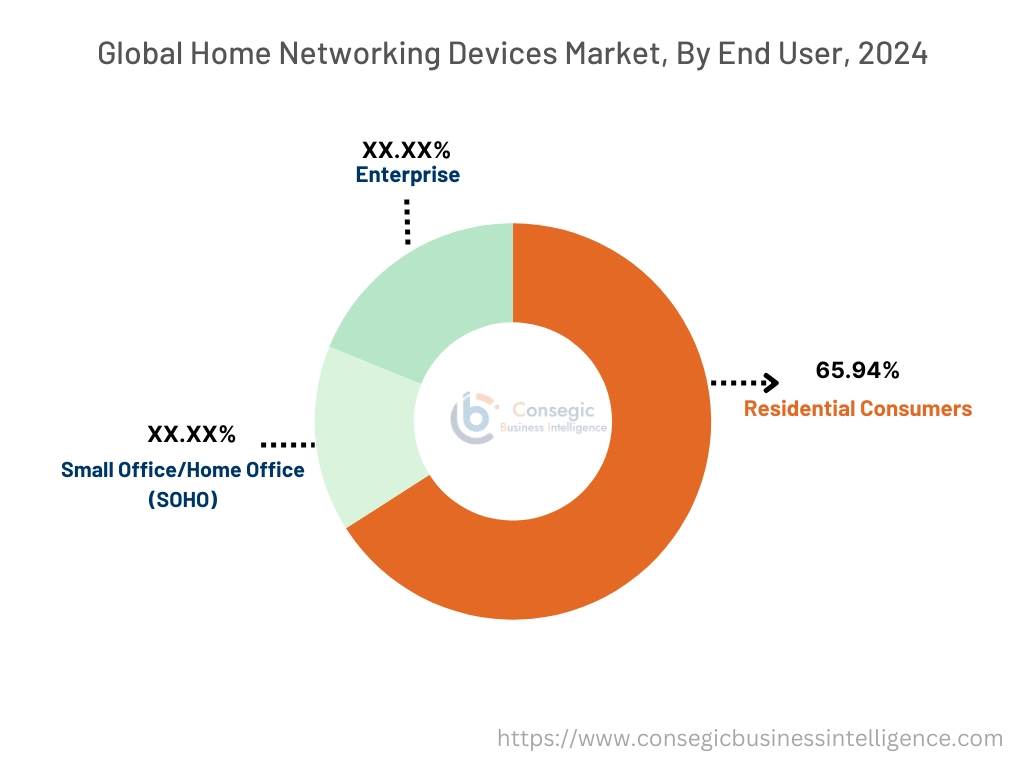
Regional Analysis:
The regions covered are North America, Europe, Asia Pacific, the Middle East and Africa, and Latin America.
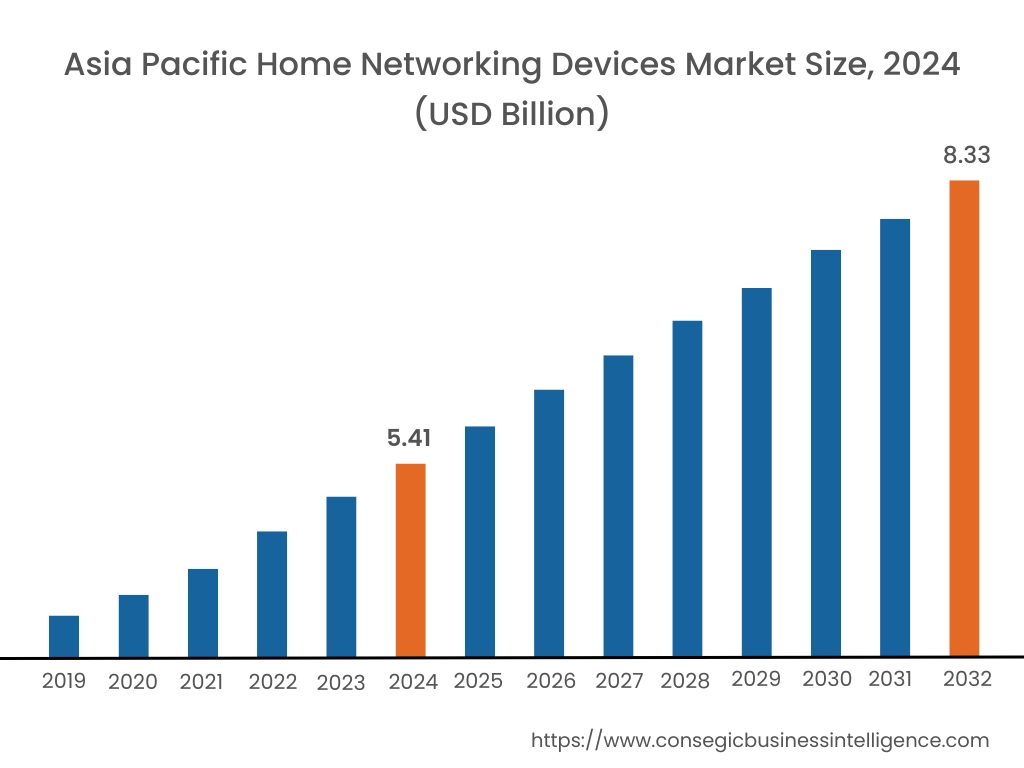
Asia Pacific region was valued at USD 5.41 Billion in 2024. Moreover, it is projected to grow by USD 5.61 Billion in 2025 and reach over USD 8.33 Billion by 2032. Out of this, China accounted for the maximum revenue share of 33.47%. The market is mainly driven by growing e-commerce industry and rapid urbanization and digitalization. Furthermore, factors including increasing internet penetration as well as rise in online gaming culture are projected to drive the market progress in Asia Pacific region during the forecast period.
- For instance, according to Telecom Regulatory Authority of India, number of internet subscribers reached 971.50 million in which wireless subscribers accounted for 927.86 million at the end of September 2024.
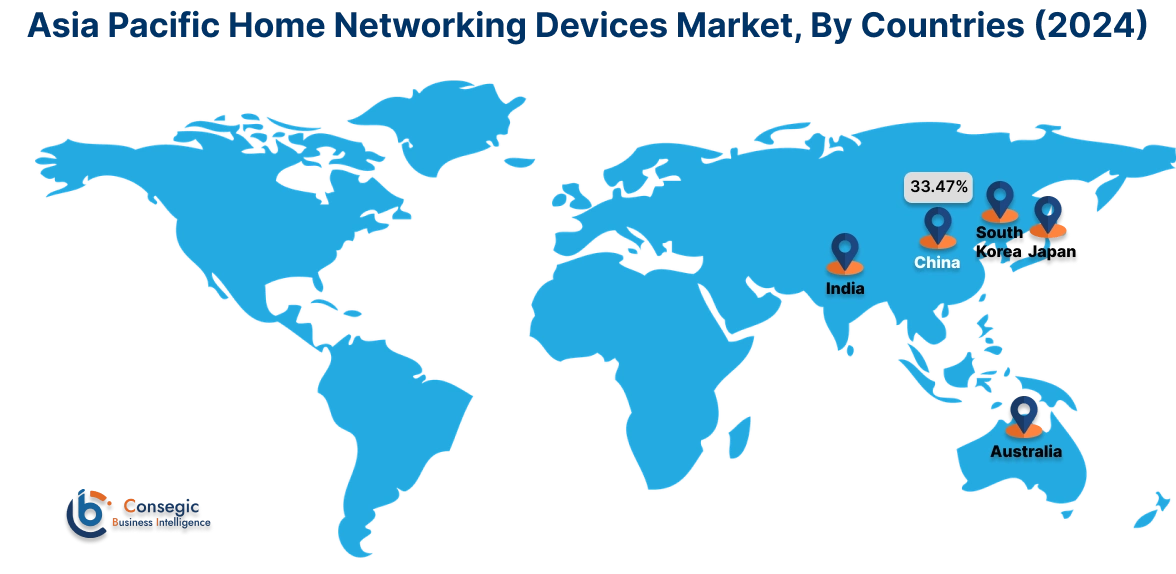
North America is estimated to reach over USD 10.41 Billion by 2032 from a value of USD 6.98 Billion in 2024 and is projected to grow by USD 7.22 Billion in 2025. The North American region's growing social media utilization offers lucrative growth prospects for the market. Additionally, the rising adoption of IoT enabled devices as well as increasing internet and 5G connectivity is driving the market development.
- For instance, according to Statista, 97.1 percent of the United States' population have accessed the internet in the year 2024 which was 91.8% in 2023 in turn is paving the way for market adoption.
The regional evaluation depicts that the digital transformation as well as smart city initiative is driving the market in Europe. Additionally, the key factor driving the market is growing regional conflicts as well as rising adoption of smart home ecosystem and increasing investment in network infrastructure is propelling the market adoption in the Middle East and African region. Further, the rising remote work and online education is paving the way for the progress of market in Latin America region.
Top Key Players and Market Share Insights:
The global home networking devices market is highly competitive with major players providing home networking devices to the national and international markets. Key players are adopting several strategies in research and development (R&D), product innovation, and end user launches to hold a strong position in the home networking devices industry. Key players in the home networking devices market include-
- Actiontec Electronics, Inc. (USA)
- ASUSTeK Computer Inc. (China)
- Belkin International (USA)
- Crestron Electronics (USA)
- Devolo AG (Germany)
- D-Link Corporation (China)
- Huawei Technologies Co. Ltd. (China)
- Ingersoll-Rand PLC (USA)
- Legrand SA (France)
- Lutron Electronic Ltd. (USA)
Recent Industry Developments :
Product launches:
- In December 2023, D-Link launched AI powered smart mesh router. The router features unparalleled Wi-Fi coverage, blazing-fast speed, reliability, and security, among others.
Partnerships & Collaborations:
- In September 2023, Charter collaborated with Qualcomm to launch advanced Wi-Fi router which features Wi-Fi 7 and 10 Gbps Wi-Fi capabilities.
Home Networking Devices Market Report Insights :
| Report Attributes | Report Details |
| Study Timeline | 2019-2032 |
| Market Size in 2032 | USD 29.67 Billion |
| CAGR (2025-2032) | 5.6% |
| By Device Type |
|
| By Features |
|
| By Connectivity Technology |
|
| By Network Standard |
|
| By End-User |
|
| By Region |
|
| Key Players |
|
| North America | U.S. Canada Mexico |
| Europe | U.K. Germany France Spain Italy Russia Benelux Rest of Europe |
| APAC | China South Korea Japan India Australia ASEAN Rest of Asia-Pacific |
| Middle East and Africa | GCC Turkey South Africa Rest of MEA |
| LATAM | Brazil Argentina Chile Rest of LATAM |
| Report Coverage |
|
Key Questions Answered in the Report
How big is the home networking devices market? +
The home networking devices market size is estimated to reach over USD 29.67 billion by 2032 from a value of USD 19.80 billion in 2024 and is projected to grow by USD 20.48 billion in 2025, growing at a CAGR of 5.6% from 2025 to 2032.
What specific segmentation details are covered in the home networking devices report? +
The home networking devices report includes specific segmentation details for device type, features, connectivity technology, network standard, end user, and regions.
Which is the fastest segment anticipated to impact the market growth? +
In the home networking devices market, the Wi-Fi 6E is the fastest growing segment during the forecast period due to increasing focus towards increasing bandwidth and reducing congestion.
Who are the major players in the home networking devices market? +
The key participants in the home networking devices market are Actiontec Electronics, Inc. (USA), ASUSTeK Computer Inc. (China), Belkin International (USA), Crestron Electronics (USA), Devolo AG (Germany), D-Link Corporation (China), Huawei Technologies Co. Ltd. (China), Ingersoll-Rand PLC (USA), and others.
What are the key trends in the home networking devices market? +
The home networking devices market is being shaped by several key trends including trend towards rise in technologies such as IoT, 5G and cloud computing is driving the adoption of network adapters as well as increasing demand for improving network connectivity for seamless network expansion is driving the need for range extenders and other are the key trends driving the market.
